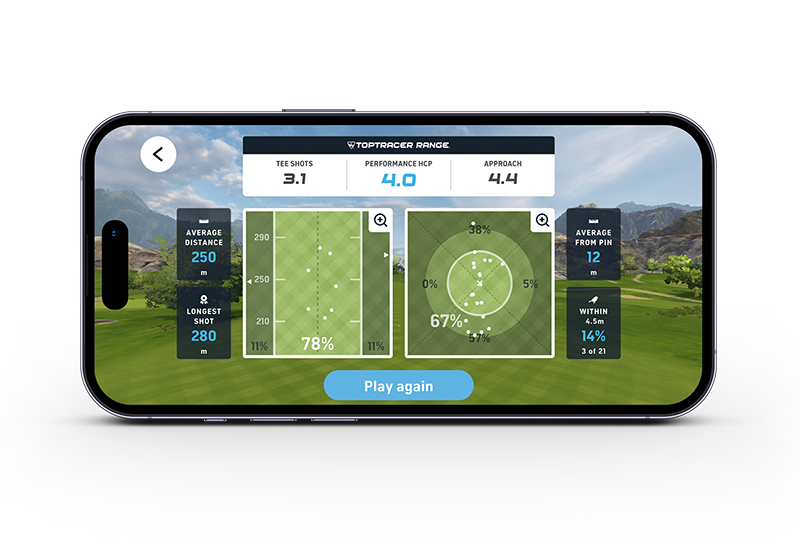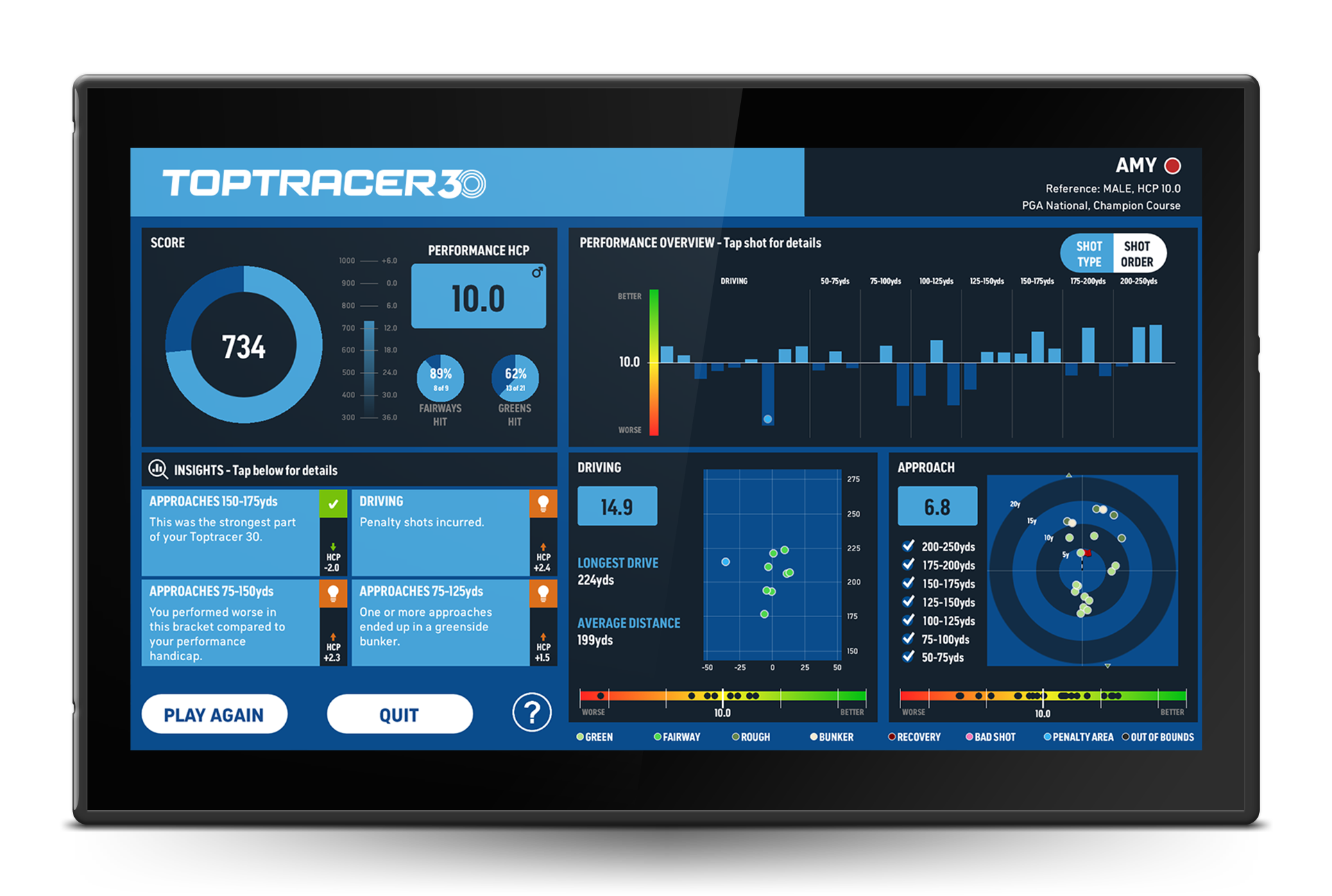Our most comprehensive assessment of golf skills is now available on both our Monitor and Mobile products! For golfers looking to improve their game or simply get a glimpse of their current performance, this 30-shot game offers robust data and personalized insights. Discover the best parts of your game as well as areas of improvement. You’re just 30 shots away from better play! Try Toptracer30 today.
How It Works
Toptracer30 consists of 30 shots: nine drives and 21 approach shots (three shots from seven different 25-yard distance brackets).
At the beginning of the game, you’ll be asked to input a reference handicap. This number will be used for comparison purposes throughout the game, so we recommend using your current handicap if you know it. As you hit each shot, T30 uses the strokes gained methodology to calculate how efficiently you move from point A to point B.
At the end of the game, T30 generates an estimated performance handicap, a total game score, and a number of personalized insights that you can use to inform your next practice session.
FAQ
We understand you may have some questions about game play, your score, and how T30 can actually improve your play. You’re in luck—we have answers.
Your T30 game score is a snapshot representation of your performance during that session and can be used to compare to other players on a leaderboard. Game scores are expressed as a whole number on a scale from 0-1,000 (0 is a novice; 1,000 is a pro).
Each shot you hit in T30 is fed into a data model that is used to calculate your performance. The data powering the T30 calculations is based on millions of shots entered into Anova by a wide variety of golfers at different performance levels. This data is then used in a model where algorithms evaluate each individual shot hit in T30. The result of this process is a strokes gained calculation for a plurality of handicap levels. The strokes gained calculations are then run through more algorithms that include a weighting step designed to make the shots hit in T30 representative of the frequency of shots hit from each distance bracket that you are likely to experience during a normal round of golf.
There are two outputs of the T30 combined algorithm:
- A Toptracer30 score that can be placed on a leaderboard and enables you to directly compare your performance with other players.
- A performance handicap that allows players familiar with traditional handicap systems to compare their performance to a commonly known scale.
Improving your T30 score means you’re improving as a golfer! Aside from regularly playing T30 during your practice sessions, here are a few tips to help you get better:
- Avoid out of bounds, penalty areas, and recovery shots. Easier said than done (we get it), but these are detrimental to your overall T30 score. Adjust your aim and shot strategy to avoid these areas and you’ll see significant performance improvements. For example: If there’s a penalty area down the left side of a fairway, aiming toward the right rough might be the rational, safe play. On approach shots, adjust your aim so water hazards are not in play.
- Look at your T30 insights. Your three “lightbulb” insights represent big opportunities for improvement.
- Learn about your own tendencies. Other Toptracer games like My Practice help you learn about what your dispersion looks like with different clubs. Use this knowledge about dispersion to adjust your strategy appropriately when playing T30.
- Share your T30 results with a coach. An instructor can help you develop practice plans to address your lightbulb insights. Regularly play the T30 game mode to ensure that the practice plan is working.
T30 looks at all 30 shots from your session and applies a weighting and calculation algorithm to generate your performance handicap. This is different from the World Handicap System, which calculates your handicap based on the eight best rounds of your last 20. As a result, players may earn a performance handicap in T30 that is higher than their world handicap number since the latter discards the worst rounds. Because T30 evaluates all observed shots, we believe your T30 handicap is more representative of your actual performance level in that moment rather than a reflection of your potential performance.
The Toptracer30 performance handicap is based on your performance during the game. The game evaluates each of your 30 shots, applies various weighting algorithms, and calculates a performance handicap. It does not provide any indication of past or future performance.
The World Handicap System, on the other hand, calculates a handicap based on your best eight rounds of the last 20 rounds played. By design, it is not a representation of your actual/average performance level, but rather an indication of a potential performance level.
Since T30 takes all 30 shots into account, one poor shot will have a bigger impact on your T30 performance handicap that it would on your WHS handicap.
The T30 performance handicap does not make any inferences about your official world handicap. It simply provides an accurate measurement of your performance specific to the 30 shots hit in the game. It is not an official handicap.
Each shot hit during a game of Toptracer30 is observed, evaluated, and analyzed, and that information is used as the basis for our personalized insights. T30 identifies the attribute of your game that currently has the most positive impact on your performance as well as three areas of your game that could be improved. Each insight also provides a calculated handicap impact. For examples, if you receive a “penalty shots incurred” insight, you will also see exactly how much this impacted your performance handicap.
The reference handicap that you input at the beginning of the game has no impact on your performance handicap or your game score. The reference handicap is merely used to determine what type of player you want to compare your T30 performance against.
We recommend entering your actual golf handicap as your reference handicap, but if you want to see how your performance compares to someone with a lower handicap, you may. In other words, if you’re normally a 15 handicap, you could enter a reference handicap of 10 and see how your performance compares to a player of that caliber.
The strokes gained methodology is the most frequently used statistical measurement on professional tours because it captures nuances in the game that would otherwise be lost when using traditional golf statistical variables. Strokes gained essentially quantifies how efficiently a player moves from point A to point B in comparison to how a known benchmark player would have performed.
In Toptracer30, the reference handicap you enter at the beginning of the game becomes the strokes gained benchmark for your session.
Yes and no. The result of your T30 session will be available for you to review in the app, but it will not be automatically used as a reference the next time you play.
Toptracer30 is a solo game and is designed for playing alone. Of course, players can compare their T30 scores with their friends, however the game mode itself only facilitates one player at a time.
Up to you! T30 can be played at any time during your practice session (although we do recommend warming up a bit before playing). Regularly incorporating T30 into your practice routine will allow you to track your performance over time.
It’s possible your profile on the Toptracer Range app isn’t 100% complete. Double-check the status of your profile by opening the app and tapping the Profile tab in the bottom right. Click Edit Profile. If there is a red dot next to Player Info, your profile is missing some details. Make sure to enter your birth year, select your gender, and click Save Changes. Since some of the calculations made in Toptracer30 are based on your gender selection, this portion of your profile must be completed in order to appear on leaderboards.






